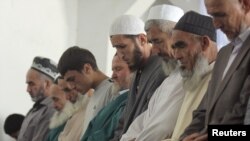The Tajik government's current dilemma is the most recent proof of the ancient adage that you reap what you sow, but the message doesn't appear to be getting through.
The Tajik government has a substantial problem, and it has been getting plenty of international attention. Dushanbe could use some friends to address it, but instead it seems intent on harassing a group that could serve as one of its best allies at the moment: the Islamic Renaissance Party of Tajikistan (HNIT).
The problem is the defection of elite security-force commander Gulmurod Halimov to the Islamic State (IS) militant group. Or more specifically, the problem is the 12-minute IS recruitment video in which the former Tajik OMON commander alternately chastises and threatens his former employer and others. The video is designed to project the grievances of a state servant but also a pious Muslim against the clumsy attempts of a corrupt government to control the practice of Islam, and unfortunately such claims cannot be wholly dismissed.
The Tajik government has undeniably been trying to control the course of Islam in the country by, among other things, regulating the age at which males may start attending mosque, forbidding women from attending mosque, ordering clerics to wear state-approved uniforms in which to preach, and providing a list of approved topics for sermons and in some cases simply supplying texts to be read at prayers. Halimov mentioned a few of these regulations.
There are more examples. But to sum it up quickly, it is ultimately the state that approves clerics, and they serve in state-approved mosques and teach at state-approved madrasahs and often include Tajikistan's president in their Friday Prayers.
One of the interesting aspects (to me, at least) of Halimov's enlistment in the IS and subsequent criticism of the Tajik government is that he is from the only Central Asian country where there is a legally registered Islamic political party: the HNIT (sometimes known as the IRPT).
Tajik authorities could use some strong statements from the HNIT both condemning Halimov's comments and endorsing the Tajik government, but that is extremely unlikely to happen.
Official Islam, Or Else
It must be mentioned that the HNIT leadership has spoken out against IS many times.
But that has not stopped the Tajik government from working to marginalize the HNIT -- some now say with the aim of eventually removing the party from the scene in Tajikistan.
The HNIT and the government led by President Emomali Rahmon were opponents during the 1992-97 Tajik civil war but agreed to a one-of-a-kind peace deal that ended hostilities and gave the HNIT 30 percent of the positions in the government, from local to ministerial.
The HNIT's share in the government was eroded over the course of the years until last March the party was finally locked out of the government entirely following dubious parliamentary elections that saw Rahmon's People's Democratic Party of Tajikistan win an outright majority, with the rest of the seats going to parties supporting the president.
Many people, and I'll name David Trilling (@dtrilling) and Edward Lemon (@EdwardLemon3) among them, noted how short-sighted this move by the government was to prevent the HNIT, the largest opposition party in Tajikistan, from winning even the token two or three seats it had held in parliament for a decade.
There have been many times in the past when the HNIT and Rahmon's government were able to cooperate to achieve common goals. The HNIT has supported government efforts as recently as 2011 to track down, and often eliminate, rogue HNIT commanders from the civil-war days. During the shaky first few years after the civil war, the HNIT even offered military help to government forces crushing the last of the pro-government paramilitary forces, once useful but inconvenient after peace was reached.
In view of the new propaganda video from former OMON commander Halimov, this might be a good time to renew the cooperation of years past.
Instead, HNIT deputy leaders Saidamar Husayni and Mahmadali Hayit met with Supreme Court Chairman Shermuhammad Shohiyon on May 30 to complain about the Interior Ministry's harassment of HNIT members and their families, as well as "cases of forcing party members to quit the party." The two leaders handed over a 189-page complaint to the court.
Reaping What They Sow
It was only the latest in a series of incidents over many years involving the HNIT, usually the release of compromising material or videos but also including the deaths and beatings of party members in not-fully-explained circumstances.
Similar, though not quite as severe, techniques have been used to sideline influential moderate clerics who would not strictly follow the government line.
The HNIT probably cannot help convince Tajik nationals who have already gone to join IS to forsake the militant group and return home. Tajiks in IS would probably view the HNIT as heretics for cooperating with a secular government.
But the HNIT is influential among the faithful in Tajikistan. Those considering whether to leave and go to Syria or Iraq will not be dissuaded by the sermons of state clerics condemning the IS in one sentence then in the next breath praising officials whom the majority of the population considers corrupt.
They might however, listen to former government opponents with much cleaner Islamic credentials when they condemn the IS.
-- Bruce Pannier, with Salimjon Aioubov and Mirzo Salimov of RFE/RL's Tajik Service






